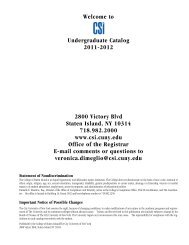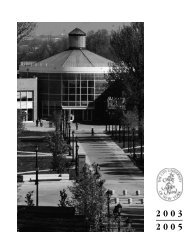Csi undergraduate conference on research, scholarship...
Csi undergraduate conference on research, scholarship...
Csi undergraduate conference on research, scholarship...
You also want an ePaper? Increase the reach of your titles
YUMPU automatically turns print PDFs into web optimized ePapers that Google loves.
P O S T E R 5<br />
Researching Film History—From<br />
Theater to Cinema<br />
Michael Maslankowski<br />
Faculty Mentor: Dr. Matthew Solom<strong>on</strong><br />
Department of Media Culture<br />
My <strong>research</strong> c<strong>on</strong>sisted of using systematic<br />
approaches for gathering informati<strong>on</strong> and evidence<br />
pertaining to selected topics in the field of film<br />
history that will be used by Professor Solom<strong>on</strong> in<br />
preparing a forthcoming book chapter and<br />
<str<strong>on</strong>g>c<strong>on</strong>ference</str<strong>on</strong>g> presentati<strong>on</strong>. The first half of my<br />
<strong>research</strong> c<strong>on</strong>sisted of the use of microfilm readers<br />
at the College of Staten Island Library to locate and<br />
copy informati<strong>on</strong> found in the microfilmed<br />
periodical, Moving Picture World, that detailed how<br />
both the magic lantern and cinema were deployed<br />
in relati<strong>on</strong> to religi<strong>on</strong> in the 20th century, between<br />
the years of 1907 to 1910. The sec<strong>on</strong>d phase of my<br />
<strong>research</strong> focused <strong>on</strong> the two films, The Man Who<br />
Laughs (1927) based <strong>on</strong> the French novel by Victor<br />
Marie Hugo and Laugh, Clown, Laugh (1928)<br />
based <strong>on</strong> the Italian play adopted from Ridi,<br />
Pagliaccio of Fausto Martini. This <strong>research</strong> was<br />
based out of the New York City Public Library for<br />
Performing Arts at Lincoln Center, where I used<br />
scrapbooks, microfilms, news clippings, and film<br />
archives to gather informati<strong>on</strong> from the 1910s and<br />
the 1920s dealing with these films/plays<br />
adaptati<strong>on</strong>s. The last phase of this <strong>research</strong> project<br />
dealt with the French archive database, Gallica. I<br />
used this database system to locate the publicati<strong>on</strong>,<br />
L’Orchestre (first published in 1856), and primarily<br />
focused <strong>on</strong> the 19th century, between the years<br />
1888 to 1891. I copied the publicati<strong>on</strong>s, detailing<br />
performance informati<strong>on</strong> pertaining to the Robert-<br />
Houdin Theatre, during an important transiti<strong>on</strong>al<br />
phase in its history to help analyze trends that<br />
occurred over this period of time.<br />
P O S T E R 6<br />
Research Poster Presentati<strong>on</strong>s<br />
Synthesis of Curcumin<br />
incorporated copolymers via ATRP<br />
Cristopher Santana<br />
Faculty Mentor-Dr. Krishnaswami Raja<br />
Department of Chemistry<br />
Curcumin based Biomimetic Polyphenols: The<br />
chemical synthesis of therapeutically relevant, welldefined<br />
high molecular weight polyphenols is very<br />
rare. We propose to employ the following general<br />
strategy: synthesizing living polymers in which the<br />
side chain pendant groups and the polymer chain<br />
end possess orthog<strong>on</strong>al reactivity, followed by the<br />
attachment of a number of water soluble,<br />
biocompatible moieties and appropriately designed<br />
curcumin derivatives to the reactive polymer side<br />
chains. In <strong>on</strong>e embodiment t-butyl acrylate will be<br />
polymerized via Atom Transfer radical<br />
Polymerizati<strong>on</strong> using an azide incorporated initiator<br />
1. The polymers with azide chain end will be<br />
deprotected to produce poly(acrylic acid) with a<br />
single azide chain end. The resulting polymer will<br />
be further reacted with varying ratios of m<strong>on</strong>oamine<br />
derivatives of curcumin followed by<br />
commercially available glucose amine (Glu-<br />
NH2)/oligoethyleneglycol-NH2 (OGE-NH2) in two<br />
sequential amidati<strong>on</strong> steps to produce libraries of<br />
polymers with varying loadings of curcumin<br />
(Scheme 1). The glucose/PEG comp<strong>on</strong>ent of the<br />
polymers serves to improve the water solubility of<br />
the polymers.<br />
Scheme 1. Synthesis of poly (acrylic acid) based<br />
water soluble curcumin side-chain polymers with<br />
reactive chain end.gestati<strong>on</strong> births.<br />
31





